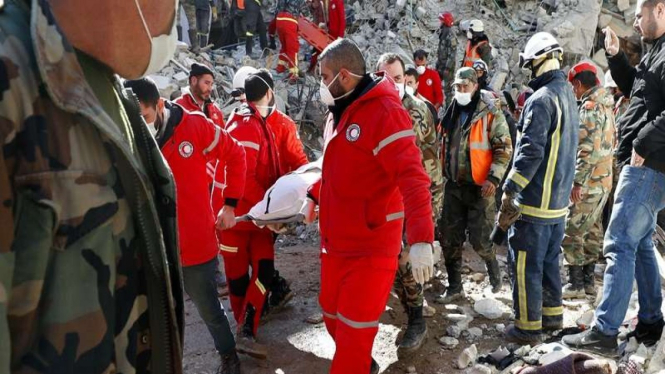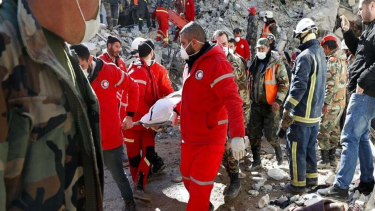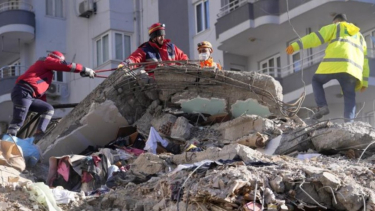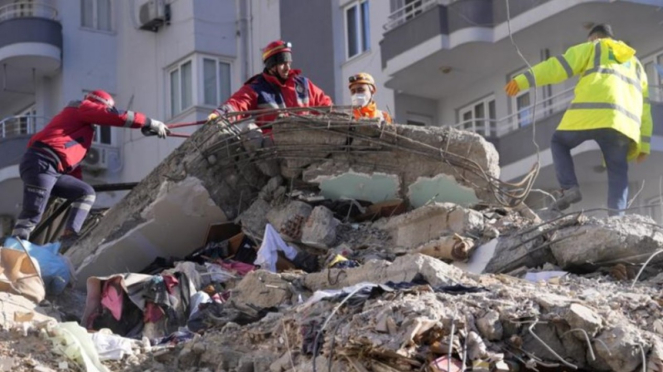The Reasons Why Turkiye Becomes Epicenter of Earthquake
- AP Photo/Omar Sanadiki
VIVA – The powerful earthquake that hit Turkiye and Syria last Monday has left tens of thousands of people dead, hundreds injured, and many buildings collapsed. Even, the death toll is still expected to increase.
According to Turkiye disaster management, Afad; the epicenter of the 7.4 magnitude quake was located in Kahramanmaras province close to the Syrian border. Shortly afterward, a 6.6 magnitude aftershock occurred in Gaziantep Province, Afad said.
Aftershocks continue to occur in Turkiye, and it is even known that Turkey is a country known as an earthquake center. Here are the reasons.
Gempa bumi dahsyat bermagnitudo 7,8 mengguncang Turki pada pada Senin 6 Februari 2023.
- AP Photo/Hussein Malla.
1. Dynamic Slab Puzzle
In Turkiye and other parts of the world, earthquakes are commonplace. But why? To answer this, it's important to look at the Earth's crust like a dynamic puzzle.
Like any puzzle, the Earth's crust is also made up of many individual pieces, namely giant oceanic plates and small continental crustal plates.
There is no conclusive answer as to how many there are. What scientists do know is that these plates move a few centimeters (about 1 inch) every year. They can move away, closer, or sometimes against each other, causing the continents above them to move. This movement is called plate tectonics.
2. Very High Earthquake Risk
Turkiye has special attention from earthquake researchers. The German Geosciences Research Center (GFZ), for example, has installed earthquake-measuring equipment there. They have even been conducting seismic monitoring since the 1980s in the country. According to GFZ records, Turkiye has a very high risk of earthquakes in the entire region around the Sea of Marmara, where Istanbul is located.
Marco Bohnhoff, a seismologist from GFZ, and other experts base this estimate on several things: the occurrence of several devastating earthquakes throughout Istanbul's history, ongoing continental drift beneath the Marmara Sea, and the existence of an earthquake zone area just outside Istanbul that has long been deserted.
"The question now is not whether an earthquake will come. The question is when," says Bohnhoff. According to him, there is plenty of evidence to suggest that the slabs in the area are "stuck".
This increases the tension. Eventually, they will no longer be able to hold the tension, and the plates pushing against each other will move in jerks of several meters in a matter of seconds, Bohnhoff says.
3. Lack of Stabilized Building Structures Importance
Earthquake waves that move the ground will endanger buildings and infrastructure, which in turn will endanger human lives as well. The level of damage depends on how strong the earthquake is.
For this reason, the way to do it is with earthquake-resistant construction. But unfortunately, this is very expensive, says Bohnhoff. In addition, the soil condition of the building is also important. In general, the harder the soil, the better, explains Bohnhoff.
"It is best if the subsoil is granite. Dry sediments such as sand or clay are less favorable," he adds.
According to Bohnhoff, ground motion amplification is more likely to occur in soft bedrock, which sometimes appears together with liquefaction. He analogizes the process to wet sand on a beach, "If you repeatedly hit the same spot in the sand, air collects in that hole. The subsurface becomes unstable," the seismologist said.



























